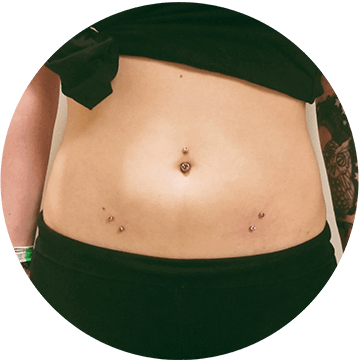Surface Piercings
almostfamous12022-09-02T18:03:31-05:00Surface Piercings

Surface Piercings
With a surface piercing, a surgical stainless-steel “surface barbell” is placed under a flat area of skin. In contrast with traditional piercings where jewelry is inserted through a protruding area (i.e., a lip or ear), surface piercings are inserted into a level area of the body. The flat part of the open staple-shaped jewelry is hidden and the ends are the only things visible on the surface of the skin. Your skin heals around the jewelry, and the threaded ends can be changed to gems, opals, or different colored or shaped beads after the piercing heals to create different looks. Surface piercings are an increasingly popular choice because of their flexibility as they can be placed almost anywhere on your body.
Types of Surface Piercings
Some of the most popular types of piercings, including the eyebrow and belly button, are actually considered surface piercings. Locations that are becoming more common include the lower back, top of the wrist, outer corner of the eye/upper cheekbones, sternum, collarbone, and nape of the neck. You can create a unique look by stacking surface piercings, adding different ends, or placing them near or in tattoos. Surface piercing jewelry requires enough depth of tissue in order to heal, so not every area is suitable for a surface bar.
Healing and Aftercare Instructions
Rejection or migration of a surface piercing is a very real possibility, and more common with surface bars than other types of body jewelry, including dermal anchors. This is when the piercing moves closer to the surface of the skin, and eventually pushes itself all the way out.
After your jewelry is inserted, follow proper aftercare instructions to avoid migration, infection, and other complications. Keep the area clean and keep clothing or accessories that could irritate the piercing away from the area. If you need to wear something over the pierced area, choose a loose cotton item that will not rub on the piercing. You should also place a bandage over the jewelry while you sleep to keep it from getting caught on clothing or bedding.
Clean the piercing two to three times a day with both glycerin soap and non-iodized sea salt. Soaking the piercing in the sea salt and water mixture softens and rinses out any drainage that can build up around the jewelry. Washing the area of the piercing with water and glycerin soap can remove any dried drainage or “crusties” from the surface.
Keep in mind that surface piercings can take up to a year or longer to fully heal. With surface piercings, you can change the ends of your jewelry after about three months if no complications are present. It is best to come in and have jewelry changes done by a piercer as unscrewing the ends can move the jewelry underneath the skin, reinjuring the tissue and prolonging the time it takes the piercing to heal.


Surface Piercings in MN, ND, IL, and MT
Learn more about surface piercings from the expert staff at Almost Famous Body Piercing. Stop by and speak personally with a piercer or contact us by phone at one of our six locations to answer any additional questions you may have.
MORE BODY JEWELRY SELECTIONS
Come in and choose your favorite jewelry style
and color from the most extensive body
jewelry inventory in the area!
Due to differences in State and local regulations, if you are a minor wishing to get pierced, or you are a parent or guardian wishing to bring a minor child in for a piercing, please call the store location you wish to visit for details on what ID is currently required and accepted for both parent and child at that specific location. If you are a guardian, proof of guardianship is required.
We reserve the right to refuse service to anyone… We do not perform piercings on people who are or seem to be intoxicated.
Everyone 18 and older wishing to get pierced must have a valid, state or federally issued picture ID like a drivers license, non-driver picture ID, or a passport. Sorry, no exceptions.
For additional information on ID requirements, call the location you wish to be pierced at, and see additional information here. Not all locations have the same ID requirements due to state and local laws.
All piercings are performed under strict sterile, sanitary conditions by trained piercing professionals.


